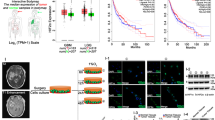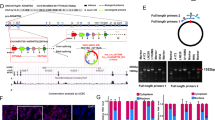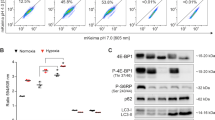Abstract
Glioblastomas are aggressive adult brain tumors, characterized by inadequately organized vasculature and consequent nutrient and oxygen (O2)-depleted areas. Adaptation to low nutrients and hypoxia supports glioblastoma cell survival, progression and therapeutic resistance. However, specific mechanisms promoting cellular survival under nutrient and O2 deprivation remain incompletely understood. Here, we show that miR-124 expression is negatively correlated with a hypoxic gene signature in glioblastoma patient samples, suggesting that low miR-124 levels contribute to pro-survival adaptive pathways in this disease. As miR-124 expression is repressed in various cancer types (including glioblastoma), we quantified miR-124 abundance in normoxic and hypoxic regions in glioblastoma patient tissue, and investigated whether ectopic miR-124 expression compromises cell survival during tumor ischemia. Our results indicate that miR-124 levels are further diminished in hypoxic/ischemic regions within individual glioblastoma patient samples, compared with regions replete in O2 and nutrients. Importantly, we also show that increased miR-124 expression affects the ability of tumor cells to survive under O2 and/or nutrient deprivation. Moreover, miR-124 re-expression increases cell death in vivo and enhances the survival of mice bearing intracranial xenograft tumors. miR-124 exerts this phenotype in part by directly regulating TEAD1, MAPK14/p38α and SERP1, factors involved in cell proliferation and survival under stress. Simultaneous suppression of these miR-124 targets results in similar levels of cell death as caused by miR-124 restoration. Importantly, we further demonstrate that SERP1 reintroduction reverses the hypoxic cell death elicited by miR-124, indicating the importance of SERP1 in promoting tumor cell survival. In support of our experimental data, we observed a significant correlation between high SERP1 levels and poor patient outcome in glioblastoma patients. Collectively, among the many pro-tumorigeneic properties of miR-124 repression in glioblastoma, we delineated a novel role in promoting tumor cell survival under stressful microenvironments, thereby supporting tumor progression.
This is a preview of subscription content, access via your institution
Access options
Subscribe to this journal
Receive 50 print issues and online access
$259.00 per year
only $5.18 per issue
Buy this article
- Purchase on Springer Link
- Instant access to full article PDF
Prices may be subject to local taxes which are calculated during checkout







Similar content being viewed by others
References
Krex D, Klink B, Hartmann C, von Deimling A, Pietsch T, Simon M et al. Long-term survival with glioblastoma multiforme. Brain 2007; 130: 2596–2606.
Stupp R, Mason WP, van den Bent MJ, Weller M, Fisher B, Taphoorn MJB et al. Radiotherapy plus concomitant and adjuvant temozolomide for glioblastoma. N Engl J Med 2005; 352: 987–996.
Louis DN, Ohgaki H, Wiestler OD, Cavenee WK, Burger PC, Jouvet A et al. The 2007 WHO classification of tumours of the central nervous system. Acta Neuropathol 2007; 114: 97–109.
Amberger-Murphy V . Hypoxia helps glioma to fight therapy. Curr Cancer Drug Targets 2009; 9: 381–390.
Evans SM, Jenkins KW, Chen HI, Jenkins WT, Judy KD, Hwang W-T et al. The relationship among hypoxia, proliferation, and outcome in patients with de novo glioblastoma: a pilot study. Transl Oncol 2010; 3: 160–169.
Spence AM, Muzi M, Swanson KR, O'Sullivan F, Rockhill JK, Rajendran JG et al. Regional hypoxia in glioblastoma multiforme quantified with [18F]fluoromisonidazole positron emission tomography before radiotherapy: correlation with time to progression and survival. Clin Cancer Res 2008; 14: 2623–2630.
Cancer Genome Atlas Research Network. Comprehensive genomic characterization defines human glioblastoma genes and core pathways. Nature 2008; 455: 1061–1068.
Verhaak RGW, Hoadley KA, Purdom E, Wang V, Qi Y, Wilkerson MD et al. Integrated genomic analysis identifies clinically relevant subtypes of glioblastoma characterized by abnormalities in PDGFRA, IDH1, EGFR, and NF1. Cancer Cell 2010; 17: 98–110.
Wu Z, Sun L, Wang H, Yao J, Jiang C, Xu W et al. MiR-328 expression is decreased in high-grade gliomas and is associated with worse survival in primary glioblastoma. PLoS ONE 2012; 7: e47270.
Silber J, Lim DA, Petritsch C, Persson AI, Maunakea AK, Yu M et al. miR-124 and miR-137 inhibit proliferation of glioblastoma multiforme cells and induce differentiation of brain tumor stem cells. BMC Med 2008; 6: 14.
Ambros V . The functions of animal microRNAs. Nature 2004; 431: 350–355.
Bartel DP . MicroRNAs: target recognition and regulatory functions. Cell 2009; 136: 215–233.
Esquela-Kerscher A, Slack FJ . Oncomirs-microRNAs with a role in cancer. Nature Rev Cancer 2006; 6: 259–269.
Ben-Hamo R, Efroni S . Gene expression and network-based analysis reveals a novel role for hsa-miR-9 and drug control over the p38 network in glioblastoma multiforme progression. Genome Med 2011; 3: 77.
Koivunen P, Lee S, Duncan CG, Lopez G, Lu G, Ramkissoon S et al. Transformation by the (R)-enantiomer of 2-hydroxyglutarate linked to EGLN activation. Nature 2012; 483: 484–488.
Makeyev EV, Zhang J, Carrasco MA, Maniatis T . The MicroRNA miR-124 promotes neuronal differentiation by triggering brain-specific alternative pre-mRNA splicing. Mol Cell 2007; 27: 435–448.
Yoo AS, Sun AX, Li L, Shcheglovitov A, Portmann T, Li Y et al. MicroRNA-mediated conversion of human fibroblasts to neurons. Nature 2011; 476: 228–231.
Gao F-B . Context-dependent functions of specific microRNAs in neuronal development. Neural Dev 2010; 5: 25.
Visvanathan J, Lee S, Lee B, Lee JW, Lee S-K . The microRNA miR-124 antagonizes the anti-neural REST/SCP1 pathway during embryonic CNS development. Genes Dev 2007; 21: 744–749.
Lim LP, Lau NC, Garrett-Engele P, Grimson A, Schelter JM, Castle J et al. Microarray analysis shows that some microRNAs downregulate large numbers of target mRNAs. Nature 2005; 433: 769–773.
Sonntag KC, Woo T-UW, Krichevsky AM . Converging miRNA functions in diverse brain disorders: a case for miR-124 and miR-126. Exp Neurol 2012; 235: 427–435.
Nelson PT, Baldwin DA, Kloosterman WP, Kauppinen S, Plasterk RHA, Mourelatos Z . RAKE and LNA-ISH reveal microRNA expression and localization in archival human brain. RNA 2006; 12: 187–191.
Hunt S, Jones AV, Hinsley EE, Whawell SA, Lambert DW . MicroRNA-124 suppresses oral squamous cell carcinoma motility by targeting ITGB1. FEBS Lett 2011; 585: 187–192.
Hatziapostolou M, Polytarchou C, Aggelidou E, Drakaki A, Poultsides GA, Jaeger SA et al. An HNF4α-miRNA inflammatory feedback circuit regulates hepatocellular oncogenesis. Cell 2011; 147: 1233–1247.
Rong Y, Durden DL, Van Meir EG, Brat DJ . 'Pseudopalisading' necrosis in glioblastoma: a familiar morphologic feature that links vascular pathology, hypoxia, and angiogenesis. J Neuropathol Exp Neurol 2006; 65: 529–539.
Kaelin WG, Ratcliffe PJ . Oxygen sensing by metazoans: the central role of the HIF hydroxylase pathway. Mol Cell 2008; 30: 393–402.
Huang X, Ding L, Bennewith KL, Tong RT, Welford SM, Ang KK et al. Hypoxia-inducible mir-210 regulates normoxic gene expression involved in tumor initiation. Mol Cell 2009; 35: 856–867.
Mathew LK, Skuli N, Mucaj V, Lee SS, Zinn PO, Sathyan P et al. miR-218 opposes a critical RTK-HIF pathway in mesenchymal glioblastoma. Proc Natl Acad Sci USA 2014; 111: 291–296.
Zhao B, Lei Q-Y, Guan K-L . The Hippo-YAP pathway: new connections between regulation of organ size and cancer. Curr Opin Cell Biol 2008; 20: 638–646.
Malt A, Cagliero J, Legent K, Silber J, Zider A, Flagiello D et al. Landin alteration of TEAD1 expression levels confers apoptotic resistance through the transcriptional up-regulation of Livin. PLoS ONE 2012; 7: e45498.
Wagner EF, Nebreda AR . Signal integration by JNK and p38 MAPK pathways in cancer development. Nat Rev Cancer 2009; 9: 537–549.
Demuth T, Reavie LB, Rennert JL, Nakada M, Nakada S, Hoelzinger DB et al. MAP-ing glioma invasion: mitogen-activated protein kinase kinase 3 and p38 drive glioma invasion and progression and predict patient survival. Mol Cancer Ther 2007; 6: 1212–1222.
Lawson SK, Dobrikova EY, Shveygert M, Gromeier M . p38alpha mitogen-activated protein kinase depletion and repression of signal transduction to translation machinery by miR-124 and -128 in neurons. Mol Cell Biol 2013; 33: 127–135.
Paillas S, Causse A, Marzi L, de Medina P, Poirot M, Denis V et al. MAPK14/p38α confers irinotecan resistance to TP53-defective cells by inducing survival autophagy. Autophagy 2012; 8: 1098–1112.
Yamaguchi A, Hori O, Stern DM, Hartmann E, Ogawa S, Tohyama M . Stress-associated endoplasmic reticulum protein 1 (SERP1)/Ribosome-associated membrane protein 4 (RAMP4) stabilizes membrane proteins during stress and facilitates subsequent glycosylation. J Cell Biol 1999; 147: 1195–1204.
Hori O, Miyazaki M, Tamatani T, Ozawa K, Takano K, Okabe M et al. Deletion of SERP1/RAMP4, a component of the endoplasmic reticulum (ER) translocation sites, leads to ER stress. Mol Cell Biol 2006; 26: 4257–4267.
Cloninger C, Bernath A, Bashir T, Holmes B, Artinian N, Ruegg T et al. Inhibition of SAPK2/p38 enhances sensitivity to mTORC1 inhibition by blocking IRES-mediated translation initiation in glioblastoma. Mol Cancer Ther 2011; 10: 2244–2256.
Li D, Chen P, Li X-Y, Zhang L-Y, Xiong W, Zhou M et al. Grade-specific expression profiles of miRNAs/mRNAs and docking study in human grade I-III astrocytomas. Omics 2011; 15: 673–682.
Godlewski J, Nowicki MO, Bronisz A, Williams S, Otsuki A, Nuovo G et al. Targeting of the Bmi-1 oncogene/stem cell renewal factor by microRNA-128 inhibits glioma proliferation and self-renewal. Cancer Res 2008; 68: 9125–9130.
Kang K, Peng X, Zhang X, Wang Y, Zhang L, Gao L et al. MicroRNA-124 suppresses the transactivation of nuclear factor of activated T cells by targeting multiple genes and inhibits the proliferation of pulmonary artery smooth muscle cells. J Biol Chem 2013; 288: 25414–25427.
Liu XS, Chopp M, Zhang RL, Tao T, Wang XL, Kassis H et al. MicroRNA profiling in subventricular zone after stroke: MiR-124a regulates proliferation of neural progenitor cells through Notch signaling pathway. PLoS ONE 2011; 6: e23461.
Acknowledgements
We thank Dr Hongwei Yu for assistance with histological preparations, Dr Jeremy Rich for providing the patient-derived tumor sphere cells, Dr Stephen Prouty for assistance with Laser-Capture Microdissection and the Simon laboratory for helpful discussions. This work was funded by the Howard Hughes Medical Institute and the National Institutes of Health (T32 GM-07229; F31CA174211). MCS is an investigator of the Howard Hughes Medical Institute.
Author information
Authors and Affiliations
Corresponding author
Ethics declarations
Competing interests
The authors declare no conflict of interest.
Additional information
Supplementary Information accompanies this paper on the Oncogene website
Supplementary information
Rights and permissions
About this article
Cite this article
Mucaj, V., Lee, S., Skuli, N. et al. MicroRNA-124 expression counteracts pro-survival stress responses in glioblastoma. Oncogene 34, 2204–2214 (2015). https://doi.org/10.1038/onc.2014.168
Received:
Revised:
Accepted:
Published:
Issue Date:
DOI: https://doi.org/10.1038/onc.2014.168
This article is cited by
-
miR-124: A Promising Therapeutic Target for Central Nervous System Injuries and Diseases
Cellular and Molecular Neurobiology (2022)
-
Potential role of microRNAs as biomarkers in human glioblastoma: a mini systematic review from 2015 to 2020
Molecular Biology Reports (2021)
-
MicroRNA-124 Reduces Arsenic-induced Endoplasmic Reticulum Stress and Neurotoxicity and is Linked with Neurodevelopment in Children
Scientific Reports (2020)
-
Oligonucleotide Therapeutics as a New Class of Drugs for Malignant Brain Tumors: Targeting mRNAs, Regulatory RNAs, Mutations, Combinations, and Beyond
Neurotherapeutics (2019)
-
MiR-9, miR-153 and miR-124 are down-regulated by acute exposure to cocaine in a dopaminergic cell model and may contribute to cocaine dependence
Translational Psychiatry (2018)



